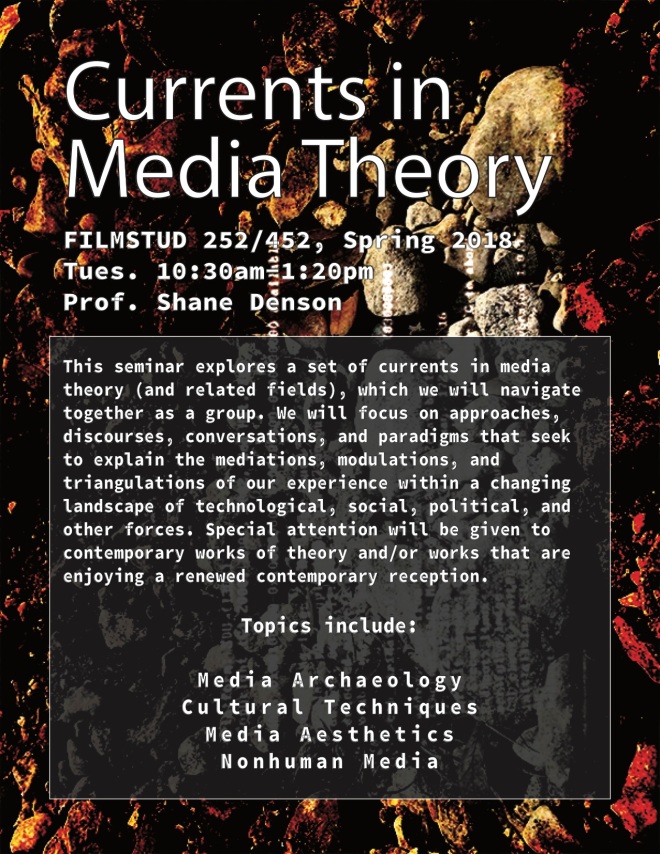
FILMSTUD 252/452 — Spring 2018 — Prof. Shane Denson — Tuesdays 10:30-1:20

FILMSTUD 252/452 — Spring 2018 — Prof. Shane Denson — Tuesdays 10:30-1:20
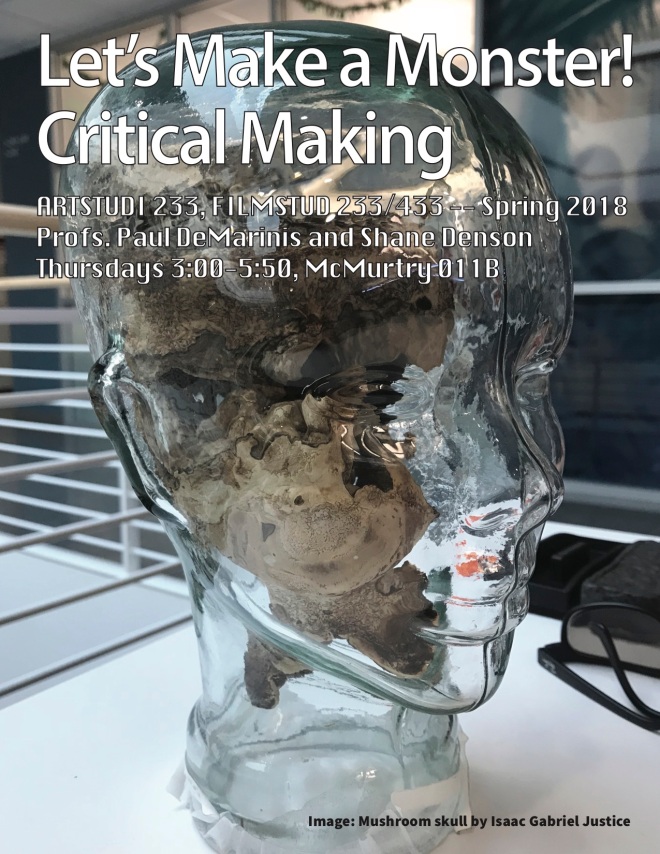
Ever since Frankenstein unleashed his monster onto the world in Mary Shelley’s novel from 1818, the notion of “technology-out-of-control” has been a constant worry of modern societies, plaguing more optimistic visions of progress and innovation with fears that modern machines harbor potentials that, once set in motion, can no longer be tamed by their human makers. In this characteristically modern myth, the act of making — and especially technological making — gives rise to monsters. As a cautionary tale, we are therefore entreated to look before we leap, to go slow and think critically about the possible consequences of invention before we attempt to make something radically new. However, this means of approaching the issue of human-technological relations implies a fundamental opposition between thinking and making, suggesting a split between cognition as the specifically human capacity for reflection versus a causal determinism-without-reflection that characterizes the machinic or the technical. Nevertheless, recent media theory questions this dichotomy by asserting that technologies are inseparable from humans’ abilities to think and to act in the world, while artistic practices undo the thinking/making split more directly and materially, by taking materials — including technologies — as the very medium of their critical engagement with the world. Drawing on impulses from both media theory and art practice, “critical making” names a counterpart to “critical thinking” — one that utilizes technologies to think about humans’ constitutive entanglements with technology, while recognizing that insight often comes from errors, glitches, malfunctions, or even monsters. Co-taught by a practicing artist and a media theorist, this course will engage students in hands-on critical practices involving both theories and technologies. Let’s make a monster!
ARTSTUDI 233, FILMSTUD 233/433 — Spring 2018 — Profs. Paul DeMarinis & Shane Denson — Thursdays 3:00-5:50pm
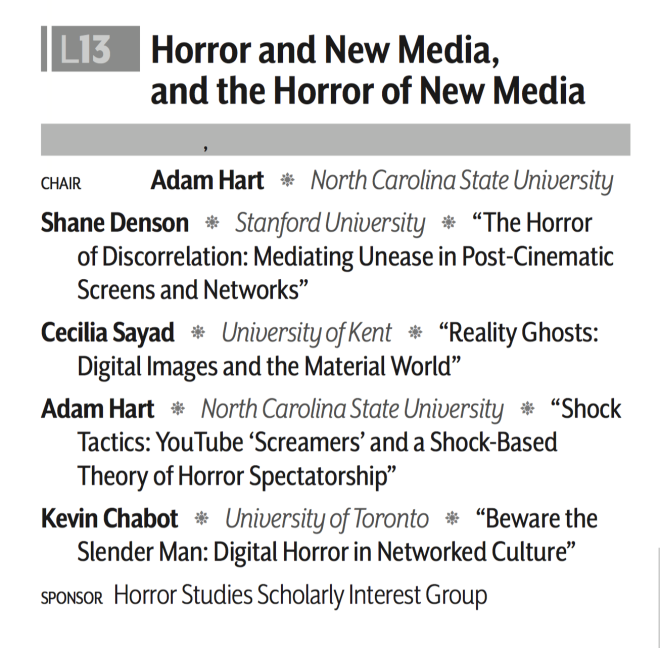
Looking forward to speaking on this panel, alongside Cecilia Sayad, Adam Hart, and Kevin Chabot at the 2018 Society for Cinema and Media Studies conference in Toronto. Panel L13, Friday, March 16, 2018 (3:15pm – 5:00pm).
Thesis of my paper: “Post-cinematic horror is a side-channel attack on our affective processing of time itself.”
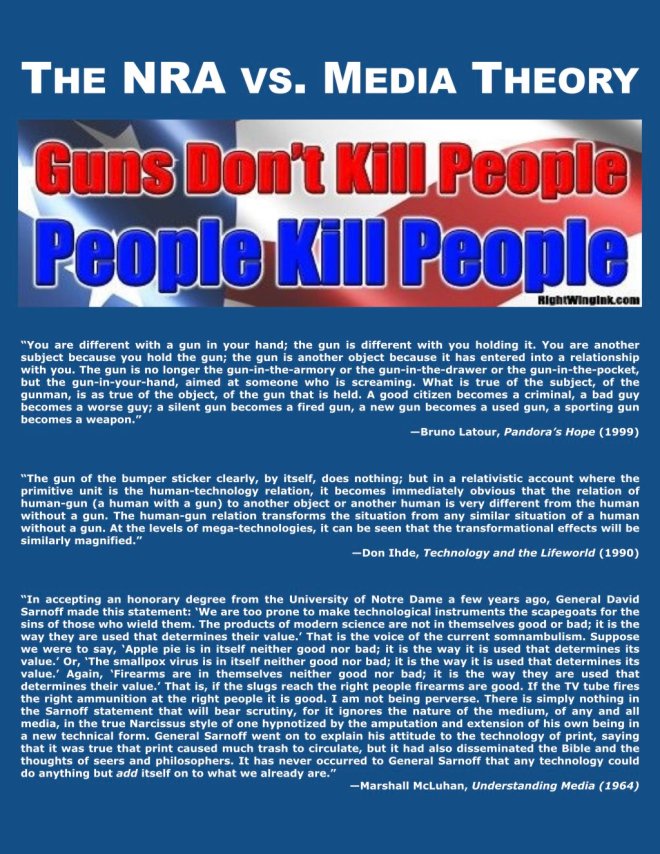
Syllabus for my graduate seminar “Currents in Media Theory” (Stanford, Spring 2018).
Video is now online from the opening colloquium of Stanford’s Frankenstein@200 Initiative: “What is Monster? What is Human?” (October 17, 2017, Cubberley Auditorium, Stanford University).
My talk, “Frankenstein, Film, and the Mediation of Media Change,” is embedded above.
Below you will find talks by my colleagues Denise Gigante (English), Aleta Hayes (Theater and Performance Studies), Russ Altman (Bioengineering, Genetics, Medicine), and Hank Greely (Law, Genetics).
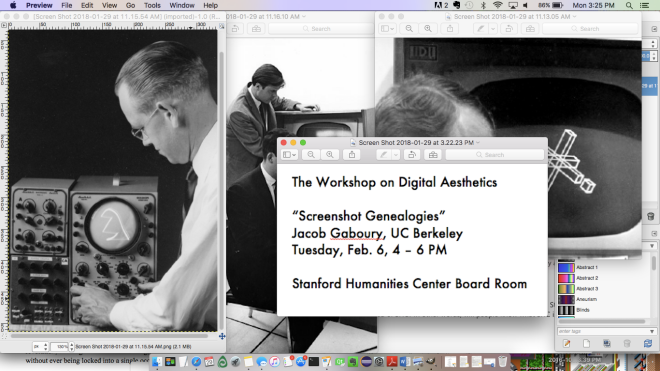
On Tuesday, February 6, 2018, Jacob Gaboury will present new work on a genealogy of the screenshot, drawn from an ongoing project on the history of computer screens and visualization.
Jacob Gaboury is an Assistant Professor of New Media History and Theory in the Department of Film & Media at the University of California, Berkeley. His work engages the history and theory of digital media, with particular focus on digital images and visual culture. His work has appeared in a wide range of popular and academic publications, including most recently the Journal of Visual Culture, Camera Obscura, Debates in the Digital Humanities, Rhizome, continent., and Art Papers.
The event will take place from 4-6pm in the Stanford Humanities Center Board Room as part of the Geballe Research Workshop on Digital Aesthetics: Critical Approaches to Computational Culture. All are welcome!
The call for papers is now out for the “Frankenstein 2018: 200 Years of Monsters” conference hosted by the Australian National University and the National Film and Sound Archive in Canberra, Australia (12 – 15 September 2018). I will be giving one of the four keynote talks — on Frankenstein in film and other media. Proposals are being solicited for talks on a range of Frankensteinian topics, including:
For more info and the CFP, take a look at the conference website: http://rsha.cass.anu.edu.au/events/conference-frankenstein-two-hundred-years-monsters
On Tuesday, January 23, 2018, Bonnie Ruberg, assistant professor of digital media and games in the Department of Informatics at UC Irvine, will be presenting work from their forthcoming monograph Video Games Have Always Been Queer. The event will take place from 4-6pm in the Stanford Humanities Center Board Room as part of the Geballe Research Workshop on Digital Aesthetics: Critical Approaches to Computational Culture.
For more information, please refer to the Stanford Humanities Center website: http://shc.stanford.edu/workshop/meetings/video-games-have-always-been-queer
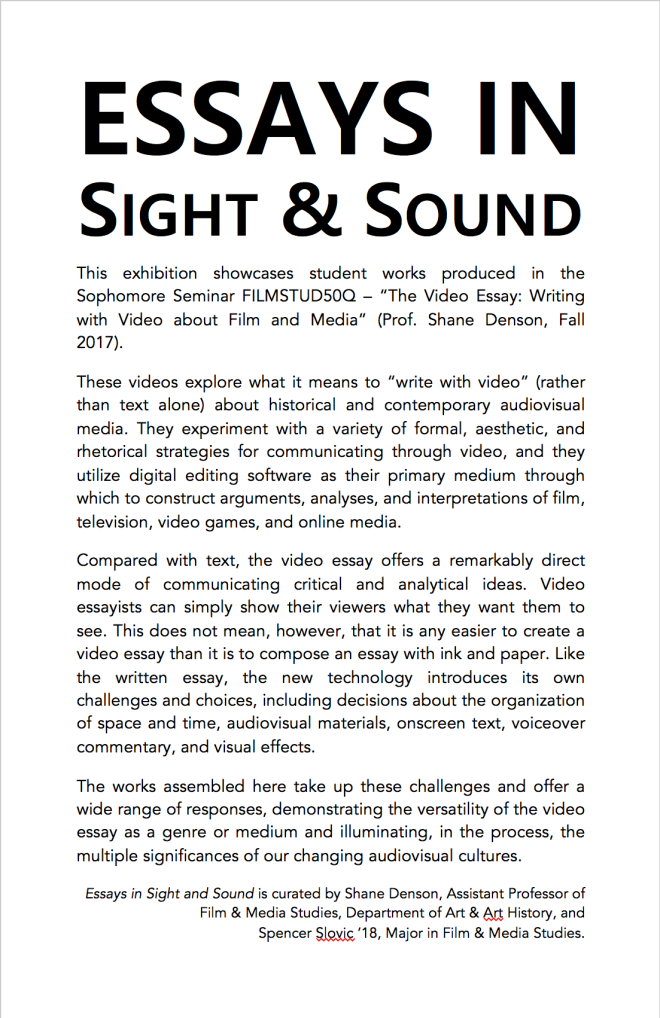
Essays in Sight and Sound — an exhibition of video essays that I am co-curating with Spencer Slovic at Stanford — opens today. The wall text (above) outlines the aims and objectives of the show. Here is a list of the 13 works included:
Explorations of Narrative
On-Again, Off-Again Relationships: A Recurring Theme, 2017
Gita Krishna
Video, 5:33TALLADEGA NIGHTS: A Reinvention of the Tragic Hero, 2017
Robin Fierberg
Video, 5:56Crafting a Cinematic Universe, 2017
Antonio Avalos
Video, 8:37THE LAST OF US: What’s in a Moment?, 2017
Matt Bernstein
Video, 3:52Focus on Color
Minelli Red, 2017
Carlos Valladares
Video, 19:10Character Design in Pixar, 2017
Rogelio Salinas
Video, 5:55Sound, Form, Aesthetics
Sight and Sound Conspire: Monstrous Audio-Vision in James Whale’s FRANKENSTEIN, 2015
Shane Denson
Video, 8:47The Arc Shot, 2017
Sabrina Medler
Video, 5:17LOCK UP: Tonal Dissonance and Homoeroticism, 2017
Francesca Watkins
Video, 10:33Culture, Context, Contour
You Eat with Your Eyes First: Comparing the Eastern and Western “Foodie” Movie Genres, 2017
Rose Adams
Video, 11:05Healing Waters, 2017
Zoe Mhungu
Video, 5:21Flexing Culture, 2017
Eleni Aneziris
Video, 4:46The Animal in the Lake: Ambient Sound in CEMETERY OF SPLENDOR, 2018
Spencer Slovic
Video, 4:30